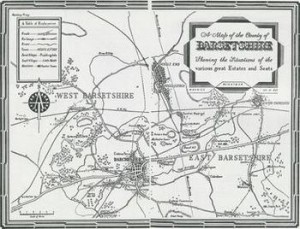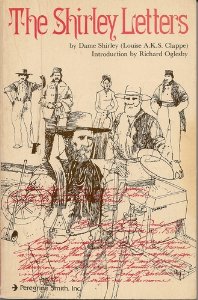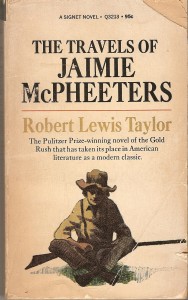 Not so much the 19th century Barsetshire of Anthony Trollope, but the 20th century version; a cycle of interlinked novels by Angela Thirkell, which were sort of chronological in that they were contemporary to the time that they were published – about one a year – between 1933 and her death in 1961. The books were part gentle social comedy, part romance and totally English. The novels were set in a mythical English county, and featured a huge cast of characters, a dozen or more families, houses grand and humble and several small towns. In passing, the books also chronicled those wrenching changes wrought by WWII and its gray aftermath. Quite frequently, a character, or a set of characters that would be front and center in one or two books, would retreat to the sidelines in another, while another character or family – mentioned in passing previously – would be the leading lights in the next. And it was not necessary to read every book in strict chronological order to know what was going on in Barsetshire, although it was obvious that the society which the books reflected had changed substantially from the relatively serene 1930s, to the wartime 1940s and into the uneasy peacetime which followed on it. Like Forrest Gump’s box of chocolates, you could pretty much dip in anywhere and enjoy.
Not so much the 19th century Barsetshire of Anthony Trollope, but the 20th century version; a cycle of interlinked novels by Angela Thirkell, which were sort of chronological in that they were contemporary to the time that they were published – about one a year – between 1933 and her death in 1961. The books were part gentle social comedy, part romance and totally English. The novels were set in a mythical English county, and featured a huge cast of characters, a dozen or more families, houses grand and humble and several small towns. In passing, the books also chronicled those wrenching changes wrought by WWII and its gray aftermath. Quite frequently, a character, or a set of characters that would be front and center in one or two books, would retreat to the sidelines in another, while another character or family – mentioned in passing previously – would be the leading lights in the next. And it was not necessary to read every book in strict chronological order to know what was going on in Barsetshire, although it was obvious that the society which the books reflected had changed substantially from the relatively serene 1930s, to the wartime 1940s and into the uneasy peacetime which followed on it. Like Forrest Gump’s box of chocolates, you could pretty much dip in anywhere and enjoy.
Some years ago, when I was blogging fretfully about how the research material I had reviewed for writing Adelsverein was leading me inexorably towards making it into more than just one book, a long-time blog fan just advised me to think of it all as Barsetshire with cypress trees and a lot of sidearms – let it rip and make it into two or three volumes. After thinking it over, I realized he was entirely right. And when I mapped out more novels set in Texas, before, during and after the events chronicled in the Trilogy, I realized that this was a most excellent way to think of those books of mine set in Texas; not as a straight start to finish ladder of a narrative, but more like an interlinked network – like Thirkell’s Barsetshire. People and characters change, over time; they have experiences, grow older and settle down, or they move off into something else. I simply couldn’t write the same character over and over again, as if nothing about them had been changed by experience and time. I was already doing this in the Trilogy – by the time of the last volume, The Harvesting, quite a lot of the narrative load was being carried by characters who had been babies or small children in the first two volumes. And there were so many characters whose experiences and back-stories I wanted to explore … really, The Harvesting was nearly twice the page-count as The Gathering, and if I gone down all those entrancing side-corridors, it might have been three times longer still.
So, some of those interesting characters demanded their own books – Margaret Becker, of course – who knew everyone who was everyone, and had a very interesting life of her own, while her brother was off adventuring on the far frontier. And with The Quivera Trail, there is Dolph Becker’s English bride – and Sam Becker’s as well. In the next book, Fredi Steinmetz’s adventures in Gold Rush California and on the various western trails will fill in his own interesting frontier experience. As I look over it all – good googly moogly, have I written six books already about these people and their web of kin, friends and associates? There are so many more at-present-minor characters begging for attention. A reader once wondered wistfully, why didn’t I do something about Willi Richter and his long sojourn among the Comanche? Then, what about little silent Grete, his sister who was retrieved after a year with them? There must be interesting material enough about Tom Becker, the Bandera Kid, who was born in a London slum under the name of Alf Trotter – but at the end of The Quivera Trail, he is a silent movie cowboy star. Surely, there is a fascinating story in that – and in Peter Vining’s brother Jamie; a small child in Deep in the Heart, and dead in Pickett’s charge at Gettysburg two books later. Little Horrie, Margaret’s grandson, a small child in the two books about Margaret, a teenager briefly mentioned in Quivera – what about him? And there is yet another thread – the daughter, or possibly the granddaughter of Race Vining’s Boston wife, coming to Texas by chance and discovering the skeleton in the familial closet?
No, not a ladder – but a net, drawing in all the various stories in our American history, in our past. And there are more of them to be told. Just wait.




Recent Comments